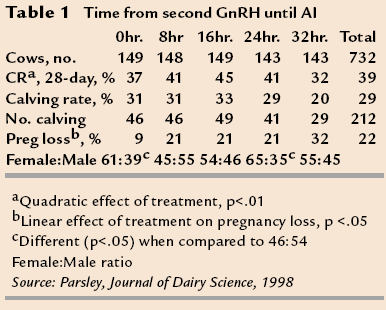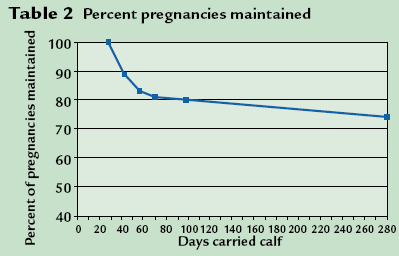Dairy: New insights into synchronization
Published: November 17, 2008
By: Cornell University PRO-DAIRY
OvSynch, the original ovulation synchronization program, is used blindly on cows, without knowledge of their day in the estrous cycle. Typically, conception rates (CRs) for this program are similar to those obtained from standing heats.
Ovulation to the first gonadotrophin-releasing hormone (GnRH) injection is important to the overall success of the program. However, the response to the initial GnRH injection varies with the stage of the follicular wave. The expected results by day of the estrous cycle are:
Day 1-4: Emergence of new follicular wave. Dominant follicle is not yet present or responsive to GnRH. This is a poor time to start the program.
Day 5-9: Nearly all cows respond to GnRH, making this an ideal time to start the program.
Day 10-16: The response of dominant follicles to GnRH begins waning on about day 10 and a new follicular wave begins to emerge, giving a variable response.
Day 17-21: The percent of animals responding at this time depends upon whether a new, or third, follicular wave is emerging. Most cows have the preferred two follicular waves during an estrous cycle, but some have three waves.
Animals that come into heat before the end of the program should be bred to standing heat.
Another option
Cows can be presynchronized (PreSynch) with prostaglandin prior to the OvSynch program, putting more of them at an optimal stage in their follicular waves. The original PreSynch program used two injections of prostaglandin 14 days apart. The OvSynch program was then started 12 days later. This puts approximately 85% of the cows at the optimal stage (day 6 to 9) and 15% in a good stage of their estrous cycles.
In published research trials this technique has increased CRs by approximately 12 to 15 percentage points over the OvSynch protocol alone.
Delaying the start of OvSynch to 14 days can make the injection scheduling easier. But the CR results won’t be good as in research.

When to breed synchronized cows
One study evaluated CRs when insemination occurred at varying times after the second GnRH (Table 1). The result: CRs were numerically highest when insemination occurred 16 hours post-GnRH.
The conception rate was lower at either end of the time frame. But, importantly, calving rates didn’t differ during the time up to 24 hours.
The lowest pregnancy loss occurred in the zero-hour animals and the greatest in the animals bred 32 hours post-GnRH. These data indicate that animals can be bred at the same time that the second GnRH is administered and have comparable calving rates.
This was an excellent study, but it definitely needs to be repeated with more than 212 calvings.
A final point: Table 2 confirms that a lot of early pregnancies are lost. Cows should be confirmed pregnant at approximately 70 days. All cows should be confirmed pregnant at dry-off.

Stay tuned
Four promising developments in reproductive science bear watching:
1. “Resynching” cows with GnRH seven days prior to pregnancy examination, putting open cows seven days into the OvSynch program when confirmed open. If this is done, optimal results would be expected when the GnRH is administered 28 to 32 days post-insemination. Before instituting this practice, consider these factors: the percent of animals typically open at examination, the cost of GnRH, the ability to regularly schedule reproductive examinations, and the timing, and expected CR, of cows started on OvSynch if found open at reproductive examination.
2. Ultrasound synchronized cows 29 days post-insemination. Give prostaglandin to all open cows with a corpus luteum (CL), followed by GnRH and insemination 36 to 48 hours later. This theory needs research, but ovarian dynamics indicate it should work.
3. As mentioned, CRs following OvSynch are similar to those obtained from standing heats, yet CRs are significantly higher with PreSynch than OvSynch. Does that mean that CRs following PreSynch are higher than
what’s achieved following a standing heat? It’s possible. If true, we probably don’t want to breed cows coming into heat after the second prostaglandin shot in the PreSynch program.
4. We balance rations for amino acids, yet consider all fat essentially the same to cows. Recent research indicates that specific fatty acids may enhance reproductive results. Specific “designer fats” have increased pregnancy rates by approximately five percentage points in field trials.
By Bill Stone, veterinarian,
PRO-DAIRY Program - Cornell University
The Manager newletter - Northeast Dairy Business
Source
Cornell University PRO-DAIRYRelated topics:
Recommend
Comment
Share

Would you like to discuss another topic? Create a new post to engage with experts in the community.






